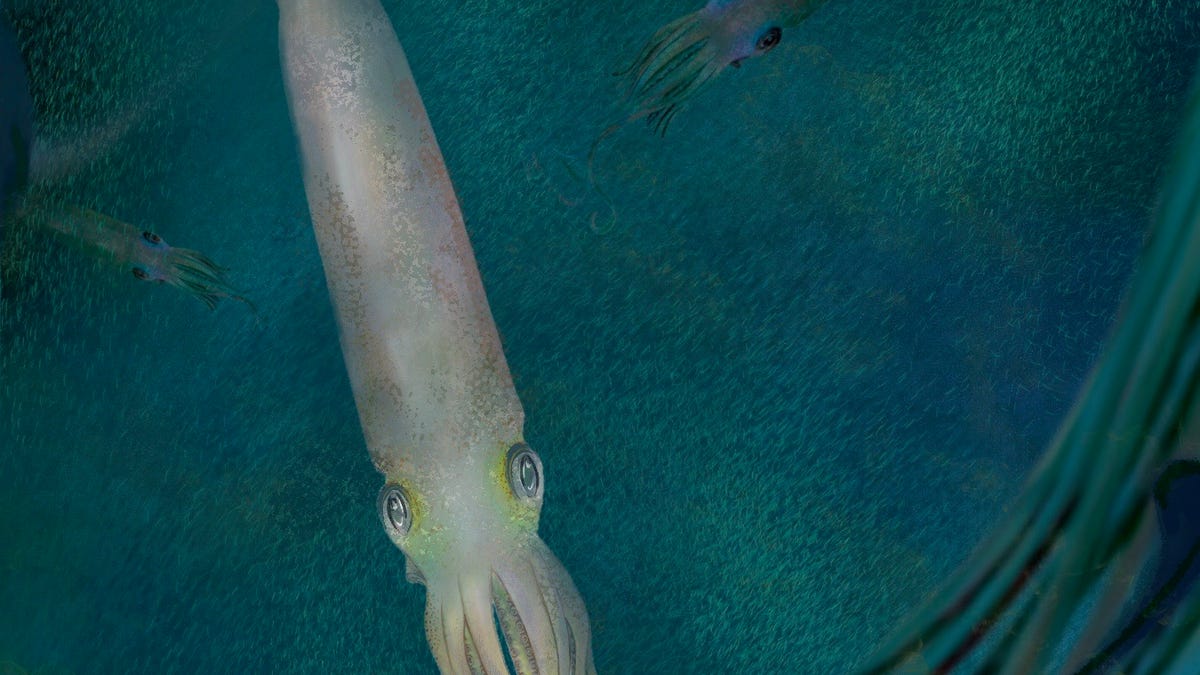Ancient Vampire Squid Species Identified and Named After US President
The translucent animal lived over 300 million years ago and used its 10 arms to capture and manipulate prey.

Artistic reconstruction of Syllipsimopodi in Montana about 330 million years ago, when the area was submerged beneath a tropical bay.
Last year, shortly after US President Joseph Biden took office, scientists wrapped up the details of their newest aquatic discovery. Though worlds apart, these milestones now share a page in history.
On Tuesday, in the journal Nature Communications, the research team announced that post-inauguration, they'd identified the oldest-known vampyropod, which is a distant relative of modern octopuses and vampire squid. The latter of the two is known for its cape-like, blood-colored body. As an homage to the 46th US president, the slippery creature earned the name Syllipsimopodi bideni.
Particularly given the breakthrough's proximity to the deadly Jan. 6 storming of the Capitol, "I wanted to somehow acknowledge the moment in a way that was more positive and forward-looking," Christopher Whalen, a researcher at Yale's department of earth and planetary sciences and at the American Museum of Natural History and lead author of the study, said in a statement.
Whalen added, "I was encouraged by the plans President Biden put forward to counter anthropogenic climate change, and his general sentiment that politicians should listen to scientists."
But beyond the stateliness of its namesake, the marine ancestor offers impressive new insights into the past. First of all, Syllipsimopodi bideni lived some 328 million years ago, the researchers say, extending vampyropod history nearly 82 million years.
Based on a well-preserved fossil specimen found in Montana, it's about 12 centimeters (4.7 inches) long and the first of its kind to be discovered with 10 functional arms. In fact, the critter was very wiggly with additional fins and rows of suckers, which, Whalen says, perhaps worked as swimming stabilizers.
The fossil of Syllipsimopodi from the Bear Gulch Limestone of Montana. It's from the Invertebrate Paleontology collections of the Royal Ontario Museum.
But overall, the research team says, Syllipsimopodi bideni looked a lot like the squids we observe swimming around right now, rocking an iconic bowling pin head, two bulging eyes and a bunch of teeny tentacles.
Per the study, it even had a pair of arms much longer than the rest, akin to modern squids' two elongated tentacles. Presumably, these overgrown limbs helped it grip prey, and the shorter ones helped manipulate the captive.
"Our findings suggest that the earliest vampyropods, at least superficially, resembled squids that are living today," Whalen said. "Syllipsimopodi bideni also challenges the predominant arguments for vampyropod origins and offers a new model for the evolution of internally-shelled cephalopods," aka the animal classification squids fall under due to their semi transparent, triangular internal shell called a gladius. The gladius is what gives them their typical torpedo-esque structure.
"Today, only squids and their relatives, and vampire squid, have a gladius," Whalen said. "Octopods have reduced it to a fin support or stylets, which are small, hard, bar-shaped structures."
Lately, the squid world has been thriving. News of Syllipsimopodi bideni comes after a line of other squid-related discoveries, including a giant, mysterious tentacled creature filmed exploring a Red Sea shipwreck and another ethereally floating in the ocean's deepest regions.

